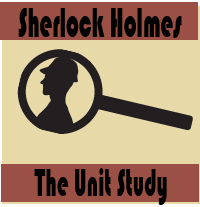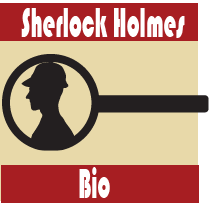Disappearance of the Lady Francis Carfax
#H - 42
What do a boot, a cab, and a coffin have in common? They demonstrate Holmes' ability to argue backwards. The Disappearance of Lady Francis Carfax analysis shows logic and detail missed by the casual observer.
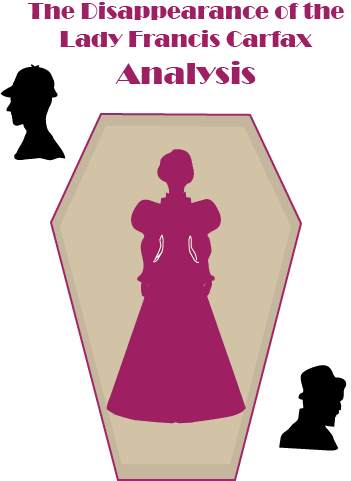
Below we analyze some of the unique features of this short story rather than summarize it. We're hoping you have actually read the story yourself. Otherwise, nothing else on this page will make a lot of sense.
Dating of the Story
- Setting of the story: While our text does not tell us when these events took place, we can deduce that it was after 1889. Peters was said to have been in a saloon fight in 1889, hence anyone would realize it took place afterwards. Elementary, no?
- Date recorded by Watson: This also is not indicated but according to Watson's last sentence in the preface of His Last Bow this is one of the stories "which have lain long in my portfolio."
- First published by Doyle in The Strand: December 1911
Opening: A Baker Street Scene
Baker Street Scenes are the most action-oriented of the 3 types of openings in Sherlock Holmes short stories.We, the readers, get to watch and listen as the two Baker Street buddies engage in a dialogue with just a bit of interpersonal tension. Holmes is curious why Watson indulged himself in a Turkish bath. Watson gives a defensive answer which leads us right into the Prounouncement (section below.)
Pre-Introductory Pronouncement and FulFillment
Observant readers will note that the entertaining dialogues that open the stories often provide an initial pronouncement and later fulfillment of the case. Let's look at what Watson's boots have introduced.Pronouncement
Sherlock treats us to TWO (2) two-part deductions from which he - the master logician - argues backwards:- Watson was at a Turkish bath because
- His boots are laced differently.
- His boots are too new to have been repaired by the bootmaker.
- Watson shared a cab this morning and sat on the left hand side.
- There are splashes of mud on the left sleeve.
- If he was alone he would have sat in the middle.
So what are we to expect from the story about to unfold? Watch Holmes reason backwards from effect to cause in order to solve our current case.
Fulfillment
Holmes:When you follow two separate trains of thought, Watson, you will find some point of intersection which should approximate the truth. We will start now, not from the lady but from the coffin and argue backwards- An elderly lady, not Francis Carfax, was in the coffin.
- A deeper coffin was specially ordered.
Right?
Watson's Role
We often think of Watson as a perplexed bystander with pen in hand, but while we are analyzing the role of Watson in assisting Holmes you'll notice he takes on a greater portion of the action in this story.- Primary Researcher - Watson only gets this role in a few other tales: Hound of Baskervilles (E-Hound) and Solitary Cyclist (F-28.) We present you with some quotes from the master of sarcasm himself regarding Watson's role as a researcher.
- Go then, my dear Watson, and if my humble counsel can ever be valued at so extravagant a rate as two pence a word, it waits your disposal night and day at the end of the Continental wire.
- So to Baden I went, after dispatching to Holmes an account of all my proceedings and receiving in reply a half-humorous commendation. (My comment: Watson reports the insults often enough; we could only wish he would have published the commendation as well.)
- To Holmes I wrote showing how rapidly and surely I had got to the roots of the matter. In reply I had a telegram asking for a description of Dr. Shlessinger's left ear. (This is a unique feature of Sherlock's we call The Irrelevant Intrusion and is described below.)
- And Holmes sums up Watson's investigation: And a singularly consistent investigation you have made, my dear Watson. I cannot at the moment recall any possible blunder that you have omitted.
- A health-giving expedition, this trip is also billed as a holiday for good old Watson who announced he was "feeling rheumatic and old" in the Pre-Introduction and hence descended into the Turkish Baths. Doctors, in those days, advised their wealthy clients to make use of what Watson called "an alternative in medicine" (ie a trip to the spa or expensive hotel.) Poor clients were out of luck. Currently doctors don't advise such alternatives but prefer pharmacology in a pill.
- Co-burglar. Once again Holmes illegally breaks into a house with Dr. Watson as his unlawful assistant as they have done before in Charles August Milverton (F-31) and Naval Treaty D-23.) This time, however, they do so in broad daylight in sight of the residents of the house.
- Holmes: We simply can't afford to wait for the police or to keep within the four corners of the law...Now Watson, we'll just take our luck together as we have occasionally done in the past.
- Their encounter with the displeased residents:
- Peters: Where is your warrant?
- Holmes drew a revolver from his pocket. This will have to serve until a better one comes.
- Holmes cheerfully describes himself as a "common burglar" and Watson "a dangerous ruffian."
- With a united effort we tore off the coffin lid. It's a good thing they did, too. However, opening a sealed casket without the proper warrant (they were still waiting for it) MIGHT have got them in a lot of trouble.
- M.D. - Ah, finally the medical man's medical skills come into play. And then, at last, with artificial respiration, with injected ether, with every device that science could suggest some flutter of life, some quiver of the eyelids, some dimming of a mirror, spoke of the slowly returning life. For those of you who have practiced advance-life support, you can now imagine Dr. Watson running the code with Sherlock as his assistant. There was NO bag-mask back then, so the artificial respiration was mouth-to-mouth. With Watson fiddling with ether, guess who would have done mouth-to-mouth?
- Biographer - Watson's main role continues to be the recorder. See our discussion below on Fictitious Transparency.
Irrelevant Intrusions
In case you missed it earlier, Sherlock interjected one of his Irrelevant Intrusions at Watson when he asked him for a description of Dr. Shlessinger's left ear. After his humourous quirky telegrams Watson brushed off the "ill-timed jest." Shame on you, Watson. Your boss is light-years ahead of you on this case even though he is back in London.Sherlock's Superiority as a Detective
It comes as no surprise to Sherlockians that Holmes left Watson in the dust. Just what had the consulting detective detected from afar while his co-researcher missed on-the-spot?- The identify of Shlessinger
- Where Lady Carfax went after leaving Lausanne (Holmes got there before Watson. Good thing for Watson too of he would have been beat up.)
- The identify of the savage who Watson suspected and Holmes trusted
- The whole story of the relationship between Carfax and Peters
- Deducts Carfax is being held prisoner in London
- Successfully hunts her locale via pawn shops
- Figures out the double coffin during his all-night vigil
Shakespeare Quote
Some Sherlockian scholars believe Sherlock must have been a Shakespearean actor prior to starting his practice as a consulting detective. In addition to great disguises (even Watson didn't recognize him when Holmes rescued him from the street fight) he quotes Shakespeare fluently:Thrice is he armed that hath his quarrel just.
This means that in addition to a sword and breastplate, the just man has truth as his third piece of armor.For Holmes and Watson their weaponry consists of Holmes' revolver, Watson's stick, and the justice of their cause.
Oh, and while I'm not saying it's not possible Holmes did a little acting in the Shakespearean theatre, his genteel birth and education would also familiarize him with Shakespeare quotes.
A Closer Look At Holmes

- "Well?" he asked in that vibrant voice which told of the fiery soul behind the cold gray face.
- Holmes's expression was as impassive as ever under the jeers of his antagonist, but his clenched hands betrayed his acute annoyance.
- Sherlock Holmes was too irritable for conversation and too restless for sleep.
Sherlock and Women
And nothing is more fun than analyzing Holmes' relationship with women. Or, perhaps, we should say his lack of relationships with women. Here's a clue:One of the most dangerous classes in the world is the drifting and friendless woman. She is the most harmless and often the most useful of mortals but she is the inevitable inciter of crime in others.Hmmm, I wouldn't mind being called "the most useful of mortals" but somehow this just doesn't come across as complimentary, does it?
Fictitious Transparency
An interesting layer of Sherlock short stories is the fictitious transparency or the reference to the stories themselves:Should you care to add the case to your annals my dear Watson," said Holmes that evening, "it can only be as an example of that temporary eclipse to which even the best-balanced mind may be expected. Such slips are common to all mortals, and the greatest is he who can recognize and repair them. To this modified credit I may, perhaps, make some claim."Translation: "Go ahead and write about this even though I goofed up." One might debate whether this statement of Holmes' is one of humility or egotism. They're both about the same with him.
Holmes' Methods
"My night was haunted by the thought that somewhere a clue, a strange sentence, a curious observation, had come under my notice and had been too easily dismissed. Then suddenly in the gray of the morning the words came back to me.This brings us back to our pre-introductory pronouncement and its fulfillment mentioned above.
Holmes continued to sift through the data to "find some point of intersection which should approximate the truth." He then "argued backward" to go from the deep coffin to the location of Francis Carfax using the same deductive abilities that alerted him to Watson's trip to the Turkish bath in a shared handsome cab.
Ending of the Story
Holmes typically vocalizes a sarcastic ending to most of his cases. Not here. It is a bit of horror as well as a little admiration that finalizes this story with a serious tone.A clever device, Watson.(Burying the victim alive.) It is new to me in the annals of crime. If our ex-missionary friends escape the clutches of Lestrade, I shall expect to hear of some brilliant incidents in their future career.This is one of the few cases in which the criminals escape Sherlock. Similar escapes also ended Engineer's Thumb (C-9) and Wisteria Lodge (H-38.)
Did he succeed? He did finally track down the Lady Francis and saved her life with but minutes to spare. I would count that as a good day's work, even if Sherlock is more serious than usual at the story's ending.
Baker Street Treasure Hunt
Our Baker Street Treasure Hunt comes up a bit bare in this tale; likely because most of it did not occur at Baker Street. Nonetheless his cane-backed chair IS a new object for those participating in the scavenger hunt or trying to recreate the famous scene.The unit study below analyzes eight of the most popular Sherlock Holmes stories. The Disappearance of Lady Francis Carfax is not one of the eight in this unit study which are investigated at greater depth.
Buy Sherlock Holmes: The Unit Study
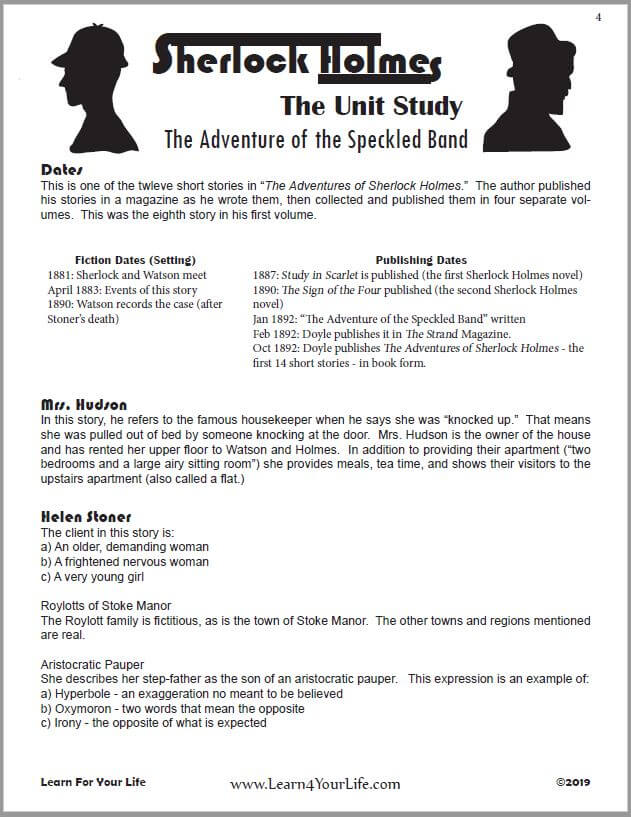
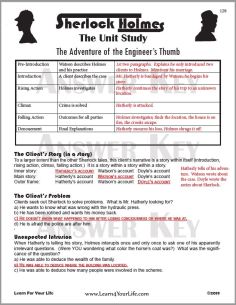
Student Guide AND Teacher's Answer Key Included
$2.99 Download - 183 pages
Eight of the most popular tales demonstrate how to investigate a detective story.
![]()
Sherlock Holmes Pages
A catalog of our pages on Sherlock Holmes.
About Our Site
Hands-On Learning


